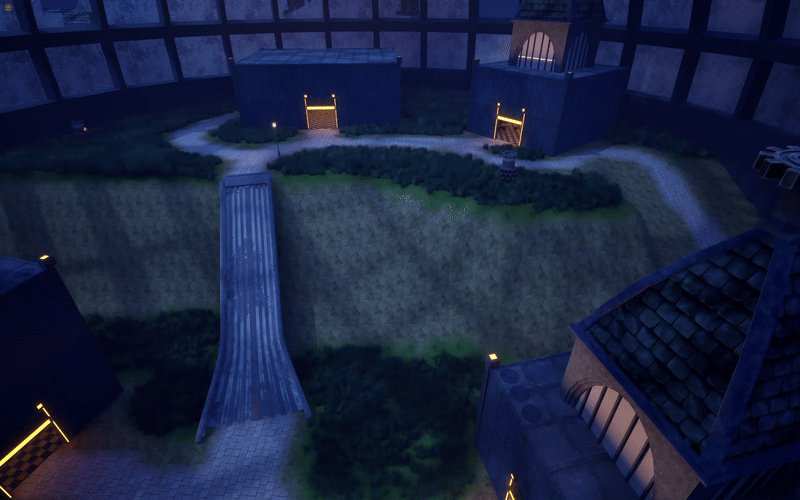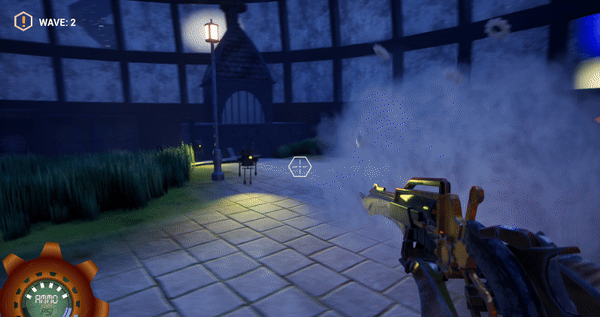
.png)
Project work summary
While working on Project Cognition, I worked on level design. I created a variety of level layouts for multiple combinations of systems and mechanics for the game. I also assisted with enemy pathing within the level.
ProjecT Summary
The dome has fallen under siege by a corrupted robot army. As the defender of the dome, hold the line as long as you can while activating boilers. Boilers power the main gate to the dome, and all need activated to open it. Fight off hordes of enemies and escape the fallen dome.
Production Summary
Project Title: Project Cognition
Project Platform: PC
Project Engine: Unreal Engine 5
Project Timeline: January 2024 - May 2024
My Role

As the primary level designer on Project Cognition, I was tasked with bridging the gap between the design and art disciplines. I would often be tasked with implementing art assets into the levels. I regularly communicated with artists as to ensure that the art direction of the game was inline with the gameplay intent.
While working on encounter design, I bridged the gap between the design and programming disciplines. I would assist our enemy designer in implementing enemy pathing volumes and enemy spawners into the level. I also regularly updated the enemy pathing volumes when the level layout changed.
Level Design Process
When it came to designing/iterating a level layout for Project Cognition, my process could be broken down into six steps:
-
Identify what elements the level needed to include, in order to align the game's experience with the core gameplay pillars
-
Draft concept sketches of the level with these considerations in mind
-
Create a level graybox in engine based on the level sketches
-
Assist enemy designer with enemy pathing volume/spawner placement
-
Test to see if the level prototype successfully aligns the game's experience with the core gameplay pillars. Continue iterating and testing until it does.
-
Collaborate with artists to integrate art assets into the level


Catering Level Design to systems/mechanics

When it came to designing/iterating level layouts for Project Cognition, I needed to account for multiple sets of systems and mechanics. Project Cognition's earlier phase of development had our programmer and systems designer experimenting with a variety of systems/mechanics combos to create different styles of gameplay.
The programmer/systems designer would deliver a new set of systems/mechanics. With that set, testing against enemies would take place, in order to see how the gameplay feels. Then, with an idea of the gameplay, sketches for potential layouts would be created.
The layouts would be catered to whatever the systems/mechanics intended the player to experience. If the intended experience was more strategic in nature, the layout would have tighter hallways and more direct paths to objectives. If the intended experience was more combat-focused in nature, the layout would have more open areas with less emphasis on objective pathing. These design considerations had to be made with haste, as to get these layouts implement for testing.
.png)
Post Mortem
Working on Project Cognition taught me the importance of iteration on a larger scale and the pipelines required to do so successfully.
While iteration was commonly taught in design classes, these were solo projects on a much smaller scale. Project Cognition was the first team project in which iteration became very important. The programming division consistently added and iterated on systems and mechanics, which required levels to be updated at a similar rate.


To be able to keep up with iteration of Project Cognition, I began solidifying pipelines between disciplines. Programming would present me a new combination of systems and mechanics, and then I would create a level layout best suited to the intended player experience. Art would present me new assets, and then I would implement them into the graybox. Enemy design would create new enemies, and then I would iterate my level layouts to suit their behaviors. Project Cognition gave me the basic for my knowledge of interdisciplinary pipelines.
Game Design Documentation
Team Shadow Wizard Money Games
Programmer/Producer: Xavier Olmstead
Environment Artists: Caleb Spainer, Tu Nguyen
Animator: Sam Feiner
Systems Designer: Isaac Eddy
Level Designer: Liam Dunphy
Enemy Designer: Natalie Froelich
UI/UX Designer: Andrew Lounsbury
Sound Designer: Kolby Sawyer
